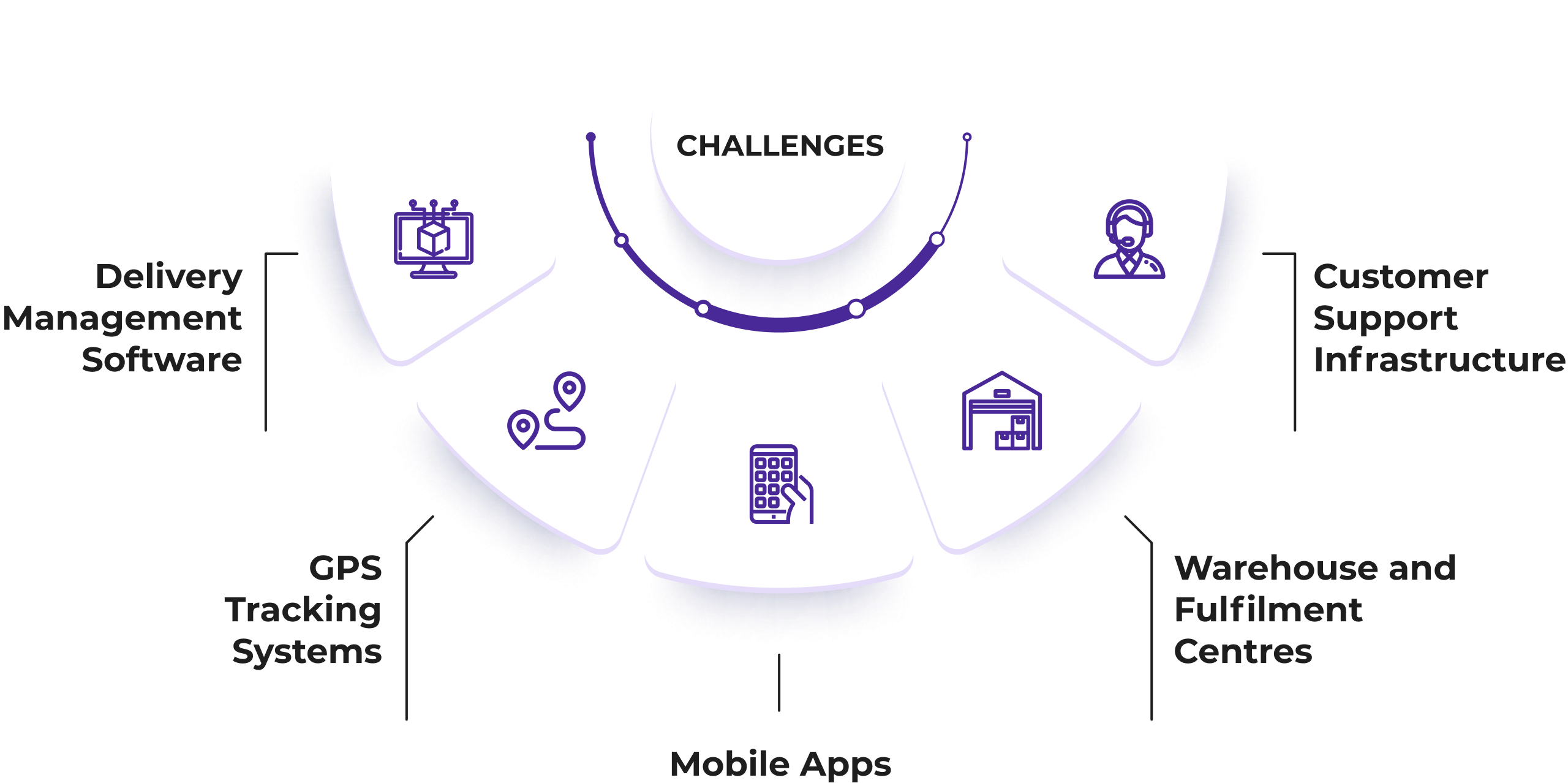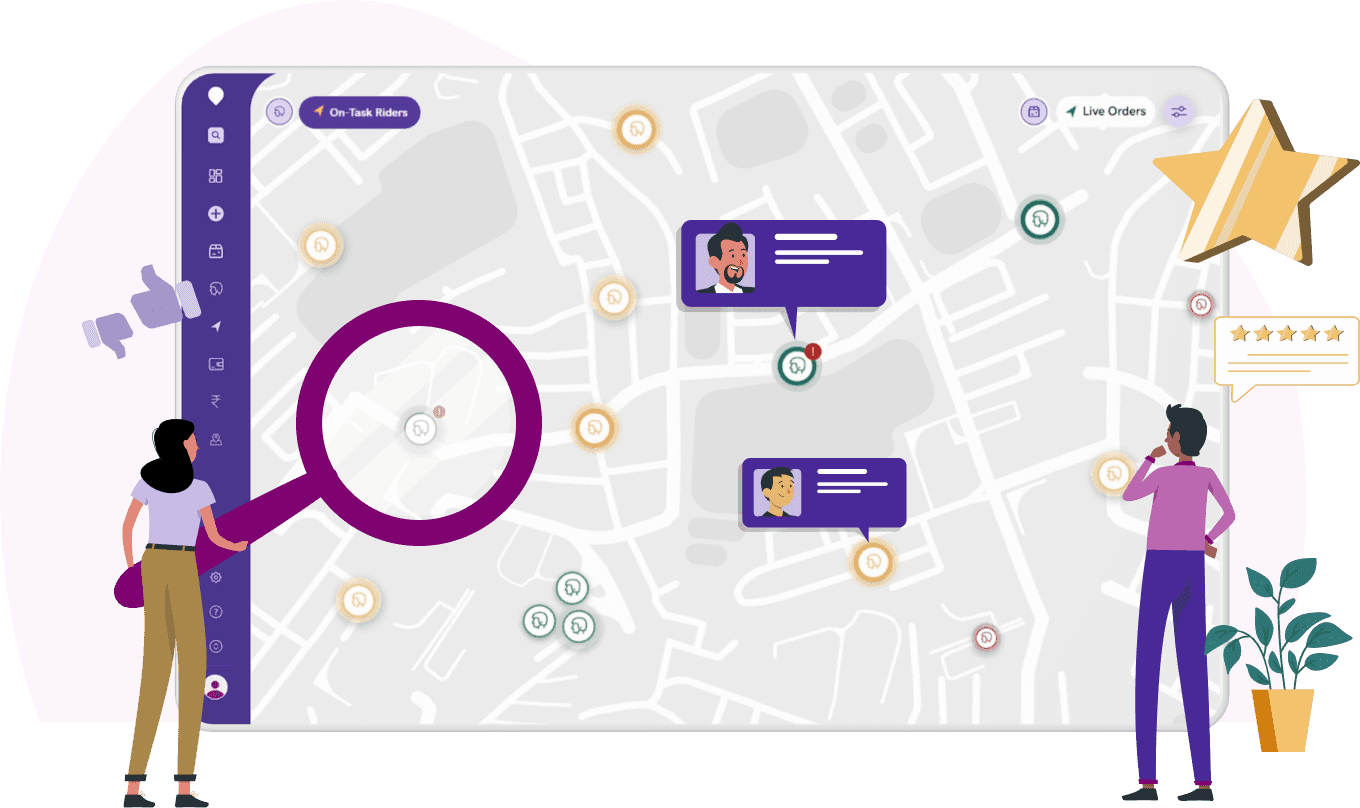To delight internet-powered customers, businesses are constantly seeking innovative ways. One such strategy that has gained significant traction in recent years is hyperlocal delivery. This revolutionary approach to logistics and distribution is reshaping the way goods and services are delivered to customers, offering unparalleled convenience, efficiency, and customization.
According to recent studies, the global hyperlocal services market is growing with a CAGR of 14.4% and is expected to reach the USD 5.9 trillion mark by 2031. Apart from the ability to get things delivered within minutes to their doorsteps, the promise of instant gratification and real-time visibility over the entire process makes the hyperlocal delivery ecosystem a consumer favorite.
In this comprehensive guide, we will delve deep into the world of hyperlocal delivery, exploring its key features, implementation strategies, success stories, and future trends. Whether you’re a business owner looking to enhance your delivery capabilities or a consumer interested in the latest trends in convenience and efficiency, this guide will provide valuable insights and actionable tips to help you navigate the exciting world of hyperlocal delivery.
Definition of Hyperlocal Delivery Model
Hyperlocal delivery goes beyond traditional delivery methods by focusing on hyper-targeted, neighborhood-based distribution networks. It leverages advanced technology, data analytics, and strategic partnerships to optimize delivery routes, minimize delivery times, and enhance the overall customer experience. From groceries and meals to retail products and services, Hyperlocal delivery has the potential to revolutionize various industries and sectors.
All in all, Hyperlocal delivery model redefines convenience by bringing goods and services directly to the doorstep of consumers with unparalleled speed and precision. Whether it’s groceries, meals, retail products, or services, Hyperlocal delivery has the transformative potential to revolutionize a wide array of industries and sectors.
By catering to the specific needs of local communities, Hyperlocal delivery not only meets but exceeds customer expectations, paving the way for a new era of efficiency and satisfaction.
Hyperlocal Delivery Planning – Why Is It Important?
While the business proposition of delivering goods to the customers’ doorstep in minutes is groundbreaking and definitely a hit with them, the inability to plan it efficiently can erode the business bottom lines like nothing else.
The essence of hyperlocal delivery lies in various aspects that directly impact the efficiency, customer experience, environmental sustainability, and competitive advantage of businesses. Hence, it becomes crucial to plan each step in the journey carefully to ensure optimal operations without impacting customer experience and delivery timelines.
Here are some key considerations for a business offering hyperlocal delivery service:
Meticulous planning of delivery routes based on proximity minimizes travel distance and time between destinations, leading to reduced operational costs and increased productivity.
Emphasis on enhanced customer experience by ensuring timeliness.
Prioritizing local deliveries and minimizing transit times for higher customer satisfaction and loyalty.
Minimizing travel distance and fuel consumption with eco-friendly practices, reflecting a commitment to social responsibility.
Having an efficient, scalable, and reliable delivery system to manage orders, stores, riders, deliveries, and CX, which is rooted in smart automation.
In summary, hyperlocal delivery planning transcends logistical necessity to become a strategic imperative. Businesses investing in robust planning processes and leveraging advanced technologies can unlock new levels of efficiency, customer satisfaction, and competitiveness in the hyperlocal delivery landscape.
Understanding Hyperlocal Delivery Services Model – Key Features and Characteristics

Neighborhood-Centric Approach: Delivery operations are organized around specific neighborhoods or localities, ensuring quick and convenient service to residents.
Advanced Technology Integration: Hyperlocal delivery leverages technology such as GPS tracking, route optimization algorithms, and mobile apps to streamline operations and enhance the customer experience.
Data-Driven Decision Making: Data analytics plays a crucial role in hyperlocal delivery, helping businesses understand customer preferences, optimize routes, and make informed decisions.
Fast and Reliable Service: By minimizing travel distances and utilizing real-time tracking, hyperlocal delivery ensures fast and reliable service, often with same-day or even immediate delivery options.
How Is Hyper Local Delivery Different from Traditional Delivery Models?
The hyperlocal delivery differs from traditional delivery models in many ways. The key areas of difference are shared below.
Proximity-Based Service
While traditional delivery may cover larger geographic areas, hyperlocal delivery focuses on serving customers within close proximity to the delivery hub or fulfillment center.
Personalized Customer Experience
Hyperlocal delivery allows for more personalized and tailored service, catering to the unique needs and preferences of each neighborhood or community.
Speed and Efficiency
By reducing travel distances and optimizing routes, hyperlocal delivery offers faster and more efficient delivery times compared to traditional models.
Greater Flexibility
Hyperlocal delivery models are often more flexible and responsive to changing demand, allowing businesses to adapt quickly to fluctuations in customer needs and preferences.
Why Is Hyperlocal Delivery Model a Win-Win for Businesses and Customers?
Hyperlocal delivery offers a range of benefits for both businesses and consumers.
By optimizing delivery routes and leveraging technology, businesses can reduce costs and improve overall operational efficiency. On the other hand, hyperlocal delivery offers convenient access to essential goods and services, often with same-day or on-demand delivery options.
Personalized service and faster delivery times can help businesses build stronger relationships with customers and foster loyalty. Likewise, consumers can benefit from shorter delivery times and quicker access to products, enhancing their overall shopping experience.
Embracing hyperlocal delivery can differentiate businesses from competitors and attract customers seeking convenience and speed. Finally, hyperlocal delivery promotes local commerce and supports small businesses within the community, contributing to economic growth and vitality.
Implementing a Hyperlocal Delivery System
Implementing a hyperlocal delivery system involves several key steps to ensure its success:
Market Research: Conduct thorough market research to identify target neighborhoods or communities with high demand for hyperlocal delivery services.
Define Service Area: Define the geographic boundaries of your service area, taking into account factors such as population density, demographics, and competition.
Build Partnerships: Establish partnerships with local businesses, suppliers, and delivery partners to ensure reliable and efficient service.
Develop Technology Infrastructure: Invest in technology infrastructure such as delivery management software, GPS tracking systems, and mobile apps to support your hyperlocal delivery operations.
Recruit and Train Staff: Hire and train delivery personnel who are familiar with the local area and can provide excellent customer service.
Test and Iterate: Conduct pilot tests and gather feedback from customers to refine your hyperlocal delivery system and address any issues or challenges.
Now that we have had an overview of setting up the hyperlocal delivery system, let us move on to learn about the technology and infrastructure requirements for the same.
Setting Up A Hyperlocal Delivery Service – Technology and Infrastructure Requirements


To support a hyperlocal delivery system, the following are some of the must-haves:
Delivery Management Software: Utilize delivery management software to optimize routes, track deliveries in real-time, and manage orders efficiently.
GPS Tracking Systems: Implement GPS tracking systems to monitor delivery vehicles and ensure accurate and timely deliveries.
Mobile Apps: Develop user-friendly mobile apps that allow customers to place orders, track deliveries, and provide feedback.
Warehouse and Fulfillment Centers: Set up local warehouses or fulfillment centers strategically located within the service area to minimize delivery times.
Customer Support Infrastructure: Establish customer support channels such as phone, email, and live chat to address customer inquiries and resolve issues promptly.
Next, let us have a closer look at the various challenges involved in setting up a hyper local delivery services network.
Hyperlocal Delivery Challenges
While hyperlocal delivery offers numerous benefits, businesses may encounter challenges during implementation. These challenges can span from having reliable and robust hyperlocal delivery apps to rider management, and customer communication to cash reconciliation management.
Logistics Complexity: Managing hyperlocal delivery operations can be complex, particularly in densely populated urban areas with heavy traffic congestion.
Scalability Issues: Scaling hyperlocal delivery operations across multiple neighborhoods or cities may pose logistical and operational challenges.
Competition: Competing with established players and larger delivery networks in the hyperlocal delivery space can be challenging for new entrants.
Customer Expectations: Meeting customer expectations for fast and reliable delivery while maintaining quality service requires careful planning and execution.
Regulatory Compliance: Adhering to local regulations and compliance requirements, such as zoning laws and delivery restrictions, is essential for operating a hyperlocal delivery service legally and ethically.
Cash Reconciliation: Ensuring proper cash handling and payment settlements across diverse payment options is crucial. However, financial operations can easily lead to high processing costs and inefficient rider-to-hub/store movements for cash settlements and rider payouts.
Now that we have had a detailed look at the different challenges involved in the hyperlocal delivery ecosystem, let us move to find how businesses can address these challenges proactively by leveraging technology and strategic partnerships. We also discuss how businesses can successfully implement and operate a hyperlocal delivery system to meet the needs of their target market.
What Is Hyperlocal Delivery Management Software and Why Is It Important?
Hyperlocal delivery management software is a specialized solution designed to streamline and optimize the process of delivering goods and services to customers within a small, geographically defined area, such as a neighborhood or city district.
This software encompasses a range of features and functionalities tailored specifically to the unique requirements of hyperlocal delivery operations, and typically includes:
Route Optimization: The software utilizes advanced algorithms to calculate the most efficient delivery routes based on factors like traffic conditions, delivery time windows, and the location of delivery destinations. This helps minimize delivery times and reduce fuel costs.
Real-Time Tracking: With GPS tracking integration, the software provides real-time visibility into the location of delivery vehicles. Dispatchers can monitor delivery progress and make informed decisions to optimize routes and schedules.
Dynamic Scheduling: Hyperlocal delivery management software allows for dynamic scheduling, enabling businesses to adjust delivery routes and schedules in response to changing demand, traffic patterns, and other variables. This flexibility helps ensure timely deliveries and maximize resource utilization.
Automated Communication: The software facilitates automated communication between drivers, dispatchers, and customers through SMS alerts, push notifications, and in-app messaging. This helps keep all stakeholders informed about the status of their deliveries and reduces the need for manual intervention.
Proof of Delivery: Hyperlocal delivery management software includes features for capturing proof of delivery, such as electronic signature capture and photo verification. This helps ensure accountability and provides evidence that orders were successfully delivered to the intended recipients.
Data Analytics: The software generates detailed analytics and reports on key performance metrics, such as delivery times, driver productivity, and customer satisfaction ratings. This data enables businesses to identify trends, measure performance, and make data-driven decisions to improve delivery operations.
Advantages of Using Hyperlocal Delivery Management Software
Automated Order Allocation
The software utilizes advanced algorithms to automate order allocation in an optimal manner to ensure zero allocation delays and greater SLA adherence. This feature streamlines the process of assigning orders to delivery drivers by automatically matching orders with the most suitable drivers based on factors such as proximity to the delivery location, driver availability, and delivery preferences.
By automating order allocation, businesses can eliminate manual intervention and ensure that orders are assigned quickly and efficiently. This not only reduces the administrative burden on dispatchers but also helps optimize delivery routes and minimize delivery times.
Dynamic Order Clubbing
Dynamic order clubbing is a powerful feature offered by hyperlocal delivery management software that allows businesses to optimize their delivery operations by combining multiple orders into efficient delivery routes in real-time.
With dynamic order clubbing, the software intelligently groups orders based on factors such as delivery locations, delivery time windows, and driver capacity. This way, businesses can reduce the number of trips required to fulfill deliveries, leading to lower fuel costs, reduced vehicle wear and tear, and decreased carbon emissions.
Real-Time Rider and Customer Communication
With this feature, riders can stay connected with customers throughout the delivery process, providing updates on order status, estimated arrival times, and any potential delays. This proactive communication helps manage customer expectations and provides transparency, leading to higher customer satisfaction levels.
Additionally, customers have the convenience of marking additional delivery instructions during the transit. They can not only select from the list of ready-made prompts but also share proper landmarks, or numbers to ensure hassle-free deliveries at any location or time of their choice.
Hassle-Free Cash Reconciliation and Rider Payout Settlements
Automation-powered hyperlocal delivery management software simplifies cash reconciliation and streamlines rider payout settlements, reducing administrative burden and ensuring accuracy in financial transactions.
This enables businesses to effortlessly reconcile cash collected by riders with the corresponding orders, eliminating the need for manual counting and accounting errors. The software automatically tracks cash payments received from customers and matches them with the associated orders, providing clear visibility into cash flows and reducing the risk of discrepancies.
Businesses can also automate rider payout settlements, ensuring timely and accurate compensation for delivery services rendered. By calculating payout amounts based on predefined criteria such as order volume, distance traveled, or delivery complexity, the software removes the complexities associated with manual payout calculations and ensures fairness and transparency in rider compensation.
Effortless Rider Onboarding With Dedicated Rider Apps
Hyperlocal delivery management software comes equipped with dedicated rider apps that streamline the onboarding process for delivery personnel, ensuring efficiency and ease of use. The rider apps provide a seamless experience for riders, guiding them through the onboarding process step by step.
From submitting necessary documents and personal information to undergoing training modules and familiarizing themselves with delivery protocols, riders can complete the onboarding process quickly and conveniently using the app. Additional features include real-time order assignment, navigation assistance, gamification, etc.
Validation and Authentication Checks
Another powerful feature of automation-powered hyperlocal delivery management systems is validation and authentication capability. These checks ensure that every transaction is secure and legitimate. They verify the identity of both customers and riders, reducing the risk of fraud and enhancing trust in the delivery process.
By implementing robust validation mechanisms, businesses can safeguard sensitive information, prevent scenarios like fake delivery attempts, and maintain the integrity of their delivery operations. From verifying customer addresses to authenticating rider credentials, these checks play a crucial role in ensuring smooth and secure hyperlocal delivery experiences for all parties involved.
Navigating Hyperlocal Delivery Landscape – How Can Pidge Help?
Pidge is an AI-powered delivery management and automation platform that not only helps businesses automate their delivery processes but also facilitates working with a hybrid interconnected rider pool.


With Pidge as their partner, businesses can boost their last-mile success, streamline their operations, optimize SLA management, and improve overall fleet efficiency, via powerful features, such as:
Accurate geocoding
Real-time order tracking
Automating repeat order fulfillment via the advanced subscriptions module
Error-free cash on delivery management
Pidge also offers its flagship Pidge Power Network that empowers both organized and unorganized third-party logistics providers (3PLs) as well as hyperlocal businesses. All the parties can lend and lease the riders and services from a hybrid pool while setting requirements and restrictions as per their preferences.
To know more, or to catch Pidge’s automation-powered solution in action, please get in touch with our experts and schedule a demo today!

Leave a Reply